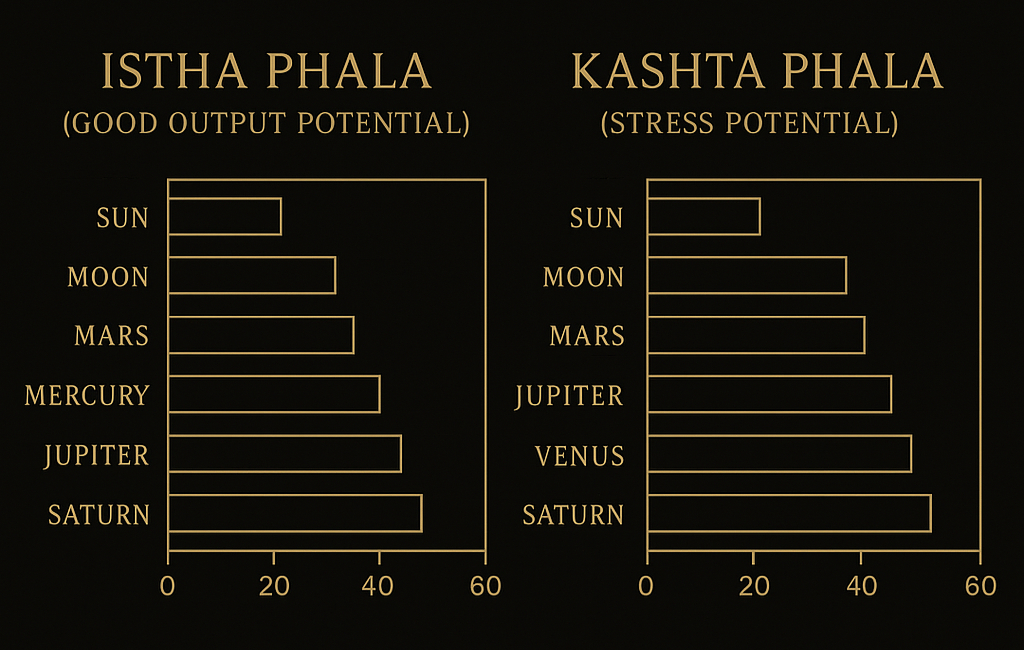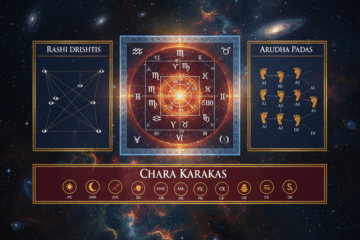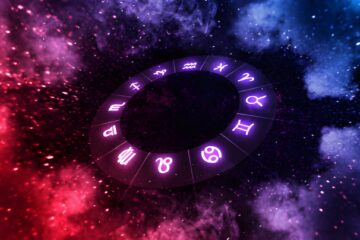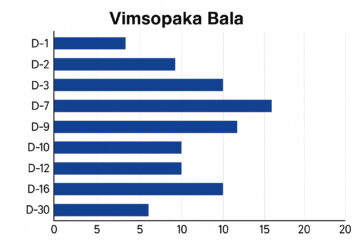Every serious student eventually hits this moment: two people have the same yoga on paper, same Mahadasha lord activated, similar transits, and yet one glides forward and the other fights through delay, exhaustion, resistance. Why? One of the core answers lives in Istha Phala and Kashta Phala in Vedic astrology.
These two values — often shown in software as IP (Istha Phala) and KP (Kashta Phala) — quantify how gracefully or how painfully a planet tends to deliver its promises. Istha Phala represents the nourishing, supportive potential of a planet. Kashta Phala represents the obstructive, friction-producing potential of a planet.
Think of it like this: Shadbala can tell you a planet is powerful. IP and KP tell you what the experience of that power feels like. Does it come through as blessing, stability, and relief, or as grinding pressure, delay, and lessons learned the hard way?
We’re going to break down what Istha Phala and Kashta Phala actually measure, how they’re calculated conceptually, what combustion and exaltation have to do with it, how to use IP/KP in Mahadasha prediction, and where students often misinterpret these numbers. By the end, you’ll know how to read IP/KP without fear — and without fantasy.
What Is Istha Phala (IP)?
Istha Phala is a measure of a planet’s ability to act in a benefic, supportive, nourishing way in your life. High Istha Phala usually points to smoother manifestation, easier cooperation from reality, and a sense that “things are falling into place” during that planet’s Mahadasha or Antardasha.
A planet with high IP tends to give results that feel wholesome, stabilizing, and internally satisfying. Even if the outcomes are not flashy, they feel right. They feel healthy. You feel like you’re growing into yourself instead of just fighting to survive.
In practice, high Istha Phala and Kashta Phala in Vedic astrology are not about moral judgment (“good planet, bad planet”). They describe ease of delivery versus resistance during delivery. That’s a big difference. Saturn with high Istha Phala is still Saturn; you will still be asked to mature. But you will experience that maturity as meaningful, not as pointless punishment.
What Is Kashta Phala (KP)?
Kashta Phala measures a planet’s potential to create difficulty, resistance, or harm. High KP suggests that the planet’s results may arrive with delay, friction, frustration, or emotional strain. It’s not always “bad.” Sometimes it’s karmic restructuring that must happen, especially if that planet rules dusthana houses (6, 8, 12).
A planet with high KP tends to push you through obstacles before allowing results. You may get what you’re supposed to get, but only after tests. The experience often feels like, “Why is this so hard?” Even if life ultimately moves forward, it does so through pressure.
So when we look at Istha Phala and Kashta Phala in Vedic astrology, we are asking: Which planets tend to open doors quietly, and which planets tend to make you fight with those doors before they finally swing open?
The Two Main Drivers Behind IP and KP
Two astronomical ideas sit behind these values. They’re not random. They’re rooted in visible sky behavior:
1. Distance from the Sun (Combustion and Visibility)
The farther a planet is from the Sun, the stronger its Istha Phala tends to be. The closer it is to the Sun, the more its Istha Phala tends to drop.
Why? Because when a planet is too close to the Sun, it’s overwhelmed by solar glare. That is what we call combustion. A combust planet is less visible in the sky and symbolically “muted,” meaning it struggles to assert its independent agenda. The planet may technically be strong in other ways, but its ability to act freely, gently, and supportively is reduced. That lowers IP.
When a planet is far from the Sun, its light and autonomy increase. It is “bright in its own right.” That supports higher Istha Phala.
This is why retrograde motion of the outer planets (Mars, Jupiter, Saturn) often lines up with higher IP. Retrograde tends to happen when those planets are at maximum elongation from the Sun — i.e., physically far from the Sun in the sky. More distance, more luminance, more autonomy, more supportive capacity.
2. Distance from the Point of Exaltation (and Debilitation)
Each planet has an exaltation zone where its energy expresses in a refined, elevated way, and a debilitation zone where its energy is frustrated. The closer a planet is to its deepest point of exaltation, the higher its Istha Phala and the lower its Kashta Phala. The closer it is to debilitation, the lower its Istha Phala and the higher its Kashta Phala.
So the two levers are:
- How free and bright is the planet (distance from Sun, non-combust vs combust)?
- How close is the planet to its exalted ideal, instead of its debilitated weakness?
This creates a subtle but important truth: a planet can have low IP without having high KP. Why? Because these two levers can move independently. A planet might be combust (so IP drops), but still sitting near exaltation (so KP stays low). Likewise, a planet can be far from the Sun (high IP boost), but sitting in or near debilitation (so KP jumps).
How the Numbers Work
Software like Jagannatha Hora gives numeric values for Istha Phala and Kashta Phala, typically from 0 to 60. Higher numbers mean more of that energy. So:
- High IP (toward 60): Strong benefic delivery potential. Results tend to manifest with support, grace, and internal satisfaction.
- Low IP (near 0–12): The planet struggles to deliver its helpful side. Results can still come, but they’ll require patience or external support (like aspects from benefics, strong dispositor, or yogic structure).
- High KP: The planet is more capable of obstructing, delaying, or introducing pressure. You get tests before rewards.
- Low KP: The planet is less likely to generate harm or resistance. Even if it doesn’t give huge blessings, at least it’s not actively sabotaging you.
A classic example used to illustrate this is the Moon exalted in Taurus around 3°, with the Sun approximately opposite in Scorpio. In that arrangement, the Moon is bright, far from combustion, and near its exaltation peak — you get maximum Istha Phala and nearly zero Kashta Phala. That is lunar nourishment in its purest delivery form.
By contrast, consider the Sun at its deepest debilitation (around 10° Libra). There, its ability to provide confident, sovereign, illuminating results is damaged. Kashta Phala spikes, Istha Phala collapses. The Sun still acts — it’s still the Sun — but people can experience ego insecurity, hits to self-confidence, or authority challenges during that Sun Mahadasha or sub-periods, unless other stabilizing factors rescue it.
Combustion, Exaltation, and the “Mixed Cases”
This is where nuance matters. Suppose Saturn is near its exaltation zone in Libra, which lowers its KP and boosts its IP. That sounds lovely. But if the Sun is sitting too close to Saturn, Saturn becomes combust. The combustion drags down Saturn’s Istha Phala because Saturn can’t express its stabilizing wisdom with full autonomy. Saturn is still exalted (so KP stays low), but IP takes a hit.
Now reverse it. Imagine a planet that’s far from the Sun (high IP via brightness) but sitting at or near its debilitation. Here, the planet is “loud but unstable.” Kashta Phala rises because it’s closer to its weakness point. So you might see a planet that is active, visible, dramatic, even charismatic during its Mahadasha — but chaotic and tiring. Strong voice, messy delivery.
This is why you cannot read Istha Phala alone. You interpret Istha Phala and Kashta Phala in Vedic astrology together. One number explains how easily blessings flow. The other explains how much friction and cost those blessings might carry.
Interpreting IP/KP in Mahadasha and Antardasha
When a Mahadasha lord has high Istha Phala, the period tends to feel aligned. The person often reports, “I felt supported,” even if they were working hard. There is usually emotional nourishment and meaningful progress.
When a Mahadasha lord has high Kashta Phala, the period can feel exhausting, delayed, and full of tests. The planet may eventually deliver what it promised, but only after you’ve been reshaped by effort. You earn the result rather than receiving it freely.
Important nuance: a benefic planet with low IP is not “cursed.” It just delivers kindness unevenly or after some delay. A malefic planet with high KP is not “evil.” It may simply require you to confront fear, discipline, boundaries, and responsibility before allowing any stability. You’re not doomed — you’re being trained.
Also remember timing logic: dashas propose, transits dispose. A planet with high IP may be gentle in its Mahadasha, but if Saturn’s transit or Rahu’s transit is aggressively triggering dusthana houses at the same time, you can still feel pressure. We never isolate one factor and declare fate from it.
The Role of the Depositor
A planet never acts alone. It acts through the sign it occupies, the nakshatra it occupies, and the Navamsa it occupies. The lords of those positions are called depositors.
When you evaluate Istha Phala and Kashta Phala in Vedic astrology, pay attention to the depositor. If a planet sits in a sign ruled by Venus, then Venus is feeding it. If Venus herself has high IP and low KP, she can uplift that planet’s ability to deliver constructive, graceful results.
This is why two people with “the same Saturn in the same sign” don’t live the same Saturn story. If your Saturn is nourished by a depositor with high IP and low KP, Saturn becomes more constructive, more stabilizing, more mature and purposeful. If your depositor is weak, Saturn can feel cold and withholding until you learn the lesson.
Are These Values Part of Shadbala?
No. Istha Phala and Kashta Phala are their own layer. They are not standard Shadbala components. Shadbala is more about positional, directional, temporal, and motional strength — the raw capability of a planet to act.
IP/KP are more psychological and experiential: “When this planet acts, how does it tend to feel?” That’s why two charts with similar Shadbala can still live very different emotional realities. You’re looking at different planets’ Istha/Kashta signatures in play.
Guidelines for Interpreting IP/KP in Practice
- Below ~12 IP: The planet struggles to deliver its good without effort, counseling, patience, or ritual/awareness. You may feel like progress is possible but constantly slipping.
- ~30+ IP: Solid. The planet can usually deliver nourishing results in its Mahadasha without too much inner turbulence.
- 45+ IP: Excellent. The planet gives support, grace, meaningful alignment. People often describe these cycles as “things finally clicked for me.”
- High KP: Expect delays, blockages, tests, or friction. You build endurance first, then receive outcomes.
Rahu and Ketu do not have direct Istha Phala and Kashta Phala values because they are not physical bodies. For the lunar nodes, we read the IP/KP of their dispositors — the lords of their signs or the planets they tightly conjoin. Rahu and Ketu inherit tone from whoever feeds them.
Finally, remember this: high IP is generally desirable, but context is everything. A high-IP Saturn can produce maturity, structure, status, and respect. That feels amazing later — even if, in the moment, it felt like “hard work.” High IP amplifies a planet’s pure intention, not necessarily instant comfort.
Important Notes
If a planet is weak in most measures but has very high Istha Phala, can it still help me?
Yes. High Istha Phala means the planet has genuine benevolent intention. You may still need aspects from benefics, a strong depositor, or supporting yogas to fully manifest the promise. But that planet is not your enemy. Its nature is trying to uplift you, even if the physical situation is imperfect.
Are auspicious and inauspicious results fixed, or can personal growth change them?
They’re not fixed. As you mature — spiritually, emotionally, psychologically — you gain the ability to channel difficult planetary signatures into growth. Istha Phala shows how willing the planet is to help. Your willingness to cooperate with that help matters just as much.
Does a functional malefic with high Kashta Phala “delay” suffering?
Not exactly. A functional malefic (like a planet ruling the 6th, 8th, or 12th house for your Lagna) with high KP tends to produce resistance directly. You may feel blocked, tested, slowed down in areas that matter to you. High KP means friction. It does not mean “no pain until later.”
Can remedies increase Istha Phala?
The number itself is fixed at birth. You cannot mathematically raise a planet’s IP. But you can reduce how harshly you experience its low IP or high KP. Charity, mantra, disciplined self-work, and conscious lifestyle adjustments can soften expression. We are not helpless. Jyotish is guidance, not sentencing.
Can a strong depositor rescue a planet with only moderate IP?
Absolutely. If the depositor has high IP and low KP, it “feeds” the planet with cleaner, softer energy. Even a planet that is a functional malefic can express more constructively when its depositor is spiritually and energetically healthy.
What if most planets in the chart have higher Kashta Phala than Istha Phala?
That usually indicates that life progress comes with grind, delay, and karmic tension. It does not mean failure. Strong yogas, a fortified Lagna, kind transits from benefics, and disciplined Saturn work can still produce excellent outcomes. It just means you earn them through persistence rather than through ease.
Does a low-IP Jupiter in its own house automatically give bad results?
No. A combust Jupiter can have reduced Istha Phala, but Jupiter in its own sign or own Kendra is still structurally protective. Low IP tells you “the grace might be slow to show.” It does not erase Jupiter’s fundamental role as a guide toward wisdom, ethics, and expansion.
Is Istha Phala plus Kashta Phala always 60?
No. They are not opposites that add to a fixed total. A planet can theoretically have very high IP and nearly zero KP (for example, exalted Moon far from the Sun). Another planet can have low IP and high KP (for example, debilitated Sun near combustion). They are related to brightness and exaltation/debilitation distance, not simply to each other.
Do gemstones change IP or KP?
Gemstones do not rewrite the math. They are meant to strengthen resonance with a planet’s constructive frequency, especially if that planet is already functionally benefic for your Lagna. We never recommend “wear the gem and all harm vanishes.” We recommend conscious, context-sensitive support — not superstition.
FAQ
How should astrologers use Istha Phala and Kashta Phala in real chart work?
Treat IP/KP as refinement tools. They tell you about ease versus resistance in delivery. A planet with strong yogas but low IP will still act — but probably with delay and emotional friction. A planet with high IP will deliver its promises more fluidly and with less inner conflict. Use IP/KP to describe how it will feel during a Mahadasha, not just what will happen.
Why aren’t IP and KP included in Shadbala?
Because Shadbala is about mechanical capacity and positional leverage (directional strength, temporal strength, motional strength, etc.). Istha Phala and Kashta Phala in Vedic astrology are about the planet’s quality of expression: benevolent support versus obstructive friction. These are different questions, so classical tradition tracks them separately.
Can meditation, mantra, or spiritual discipline help with high Kashta Phala?
Yes. You cannot change the fact that a certain planet carries high KP, but you can absolutely change your relationship with it. Inner work improves resilience, acceptance, humility, and clarity — all of which reduce the destructive side of that planet’s friction. You start using the pressure as training instead of letting it break you.
Is high Istha Phala always a blessing?
Usually yes, but with nuance. High IP amplifies the planet’s capacity to act in a way that feels supportive. For benefics like Jupiter or Venus, that feels like grace, wisdom, affection, guidance. For malefics like Saturn or Mars, high IP still amplifies them — which can mean intense discipline, confrontation, or responsibility delivered in a “this is for your growth” way. High IP does not mean “soft.” It means “purposeful and constructive.”
What if a chart shows strong yogas but most planets have low IP?
That’s a “work-for-it” chart. The yogas are real. The promise is there. But the person will likely access those promises only through effort, humility, service, and persistence. The life story may be: “Nothing was handed to me. I had to earn every inch.” That’s not failure. That’s karma asking for conscious participation.
Stay With Much Needed Astro
Much Needed Astro teaches Jyotish the way it’s meant to be practiced: honestly, technically, without fear-mongering. We look at Istha Phala and Kashta Phala, depositor strength, combustion, Mahadasha timing, and functional benefic vs functional malefic so you can read your own chart without superstition.
If you’re serious about studying real Jyotish, stay with Much Needed Astro — no fluff, no fear-mongering, just clarity you can actually use.



